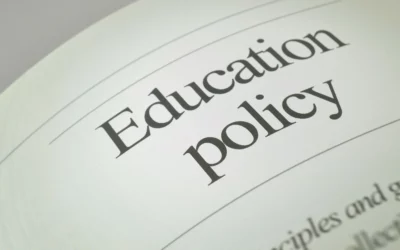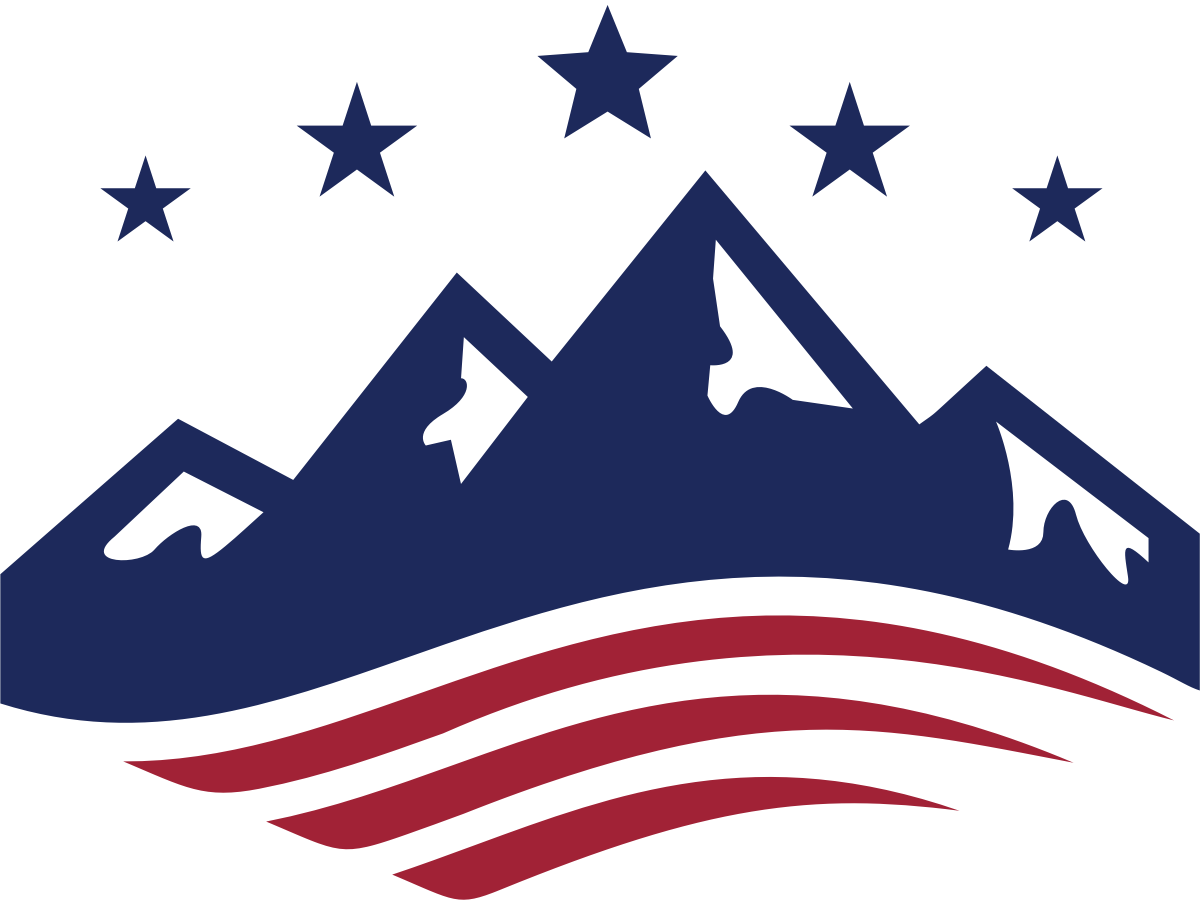
Written by Christine Cooke Fairbanks
January 11, 2024

With policymakers heading into the legislative session, reviewing the status of school types in our state is a valuable exercise. Last year, I wrote about the status of public district schools and public charter schools.
This year’s enrollment data can prompt discussion about a long-term plan for education.
Enrollment changes across the state
Enrollment in Utah public schools – both district and charter schools – garnered media attention after the October headcount made available by the Utah State Board of Education.
That is because district school enrollment has declined by about 2,000 students, which is a -0.03% change from the previous year. (Enrollment dropped from 674,650 students to 672,662, to be exact.)
Yet, public charter school enrollment grew. Since last year, an additional 513 students have been enrolled in the state’s charters, which is about a 1% change from last year’s numbers. (Last year 78,732 Utah students were enrolled and now 79,245 are enrolled.)
According to the data available from the Utah State Board of Education, this is the first time that district school enrollment has dipped in at least a decade, apart from when the COVID-19 pandemic hit. (For obvious reasons, fears of illness and closing schools had an impact on enrollment.)
School districts show a mix of enrollment changes
Enrollment changes hit districts differently. Among the state’s largest school districts – Alpine, Davis, Granite, Jordan and Nebo – there was a mix of enrollment changes: enrollment declines in three of them (Davis, Granite and Jordan) and increases in two (Alpine and Nebo).
Among the smallest districts, we see a similar mix: Only one saw a decrease (Wayne); one stayed the same in terms of enrollment numbers (Daggett); and three had enrollment increases (Piute, Rich and Tintic).
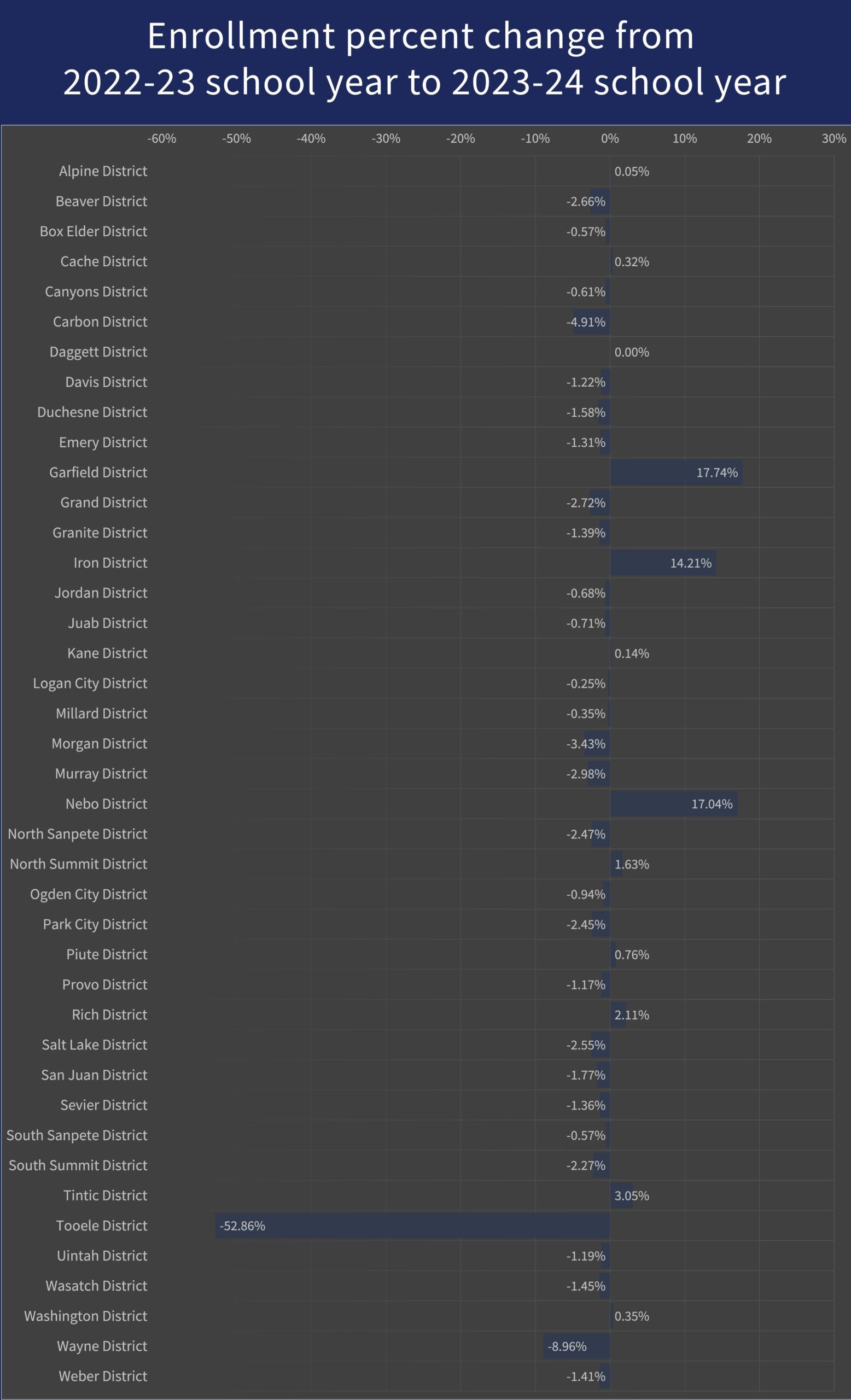
Rural districts
Rural Utah was hit with dropping enrollment too. A large majority of Utah rural districts saw lowering enrollment. Of the 26 districts identified as rural in the state (according to the Utah Rural Schools Association), 17 saw declines, one district saw no changes, and eight saw increases. That means over 65% of rural school districts saw decreases.
Interestingly, on the other hand, two rural districts had some of the largest enrollment percentage changes among districts overall: Iron County and Garfield County, both with increasing enrollment. (See the Rural Districts chart.)
High-poverty and low-poverty districts
Districts we identified as high-poverty – 40% or more economically disadvantaged students – were likewise hit with drops in student enrollment. Of the 15 districts that hit this threshold, all but one (Piute) saw a dip in numbers. That is, 93% of all high-poverty districts according to our metric saw their enrollment numbers diminish, which is obviously significant.
Even among those districts we identified as low-poverty – or those with 25% or less economically disadvantaged students – 60% saw their enrollment numbers reduced.
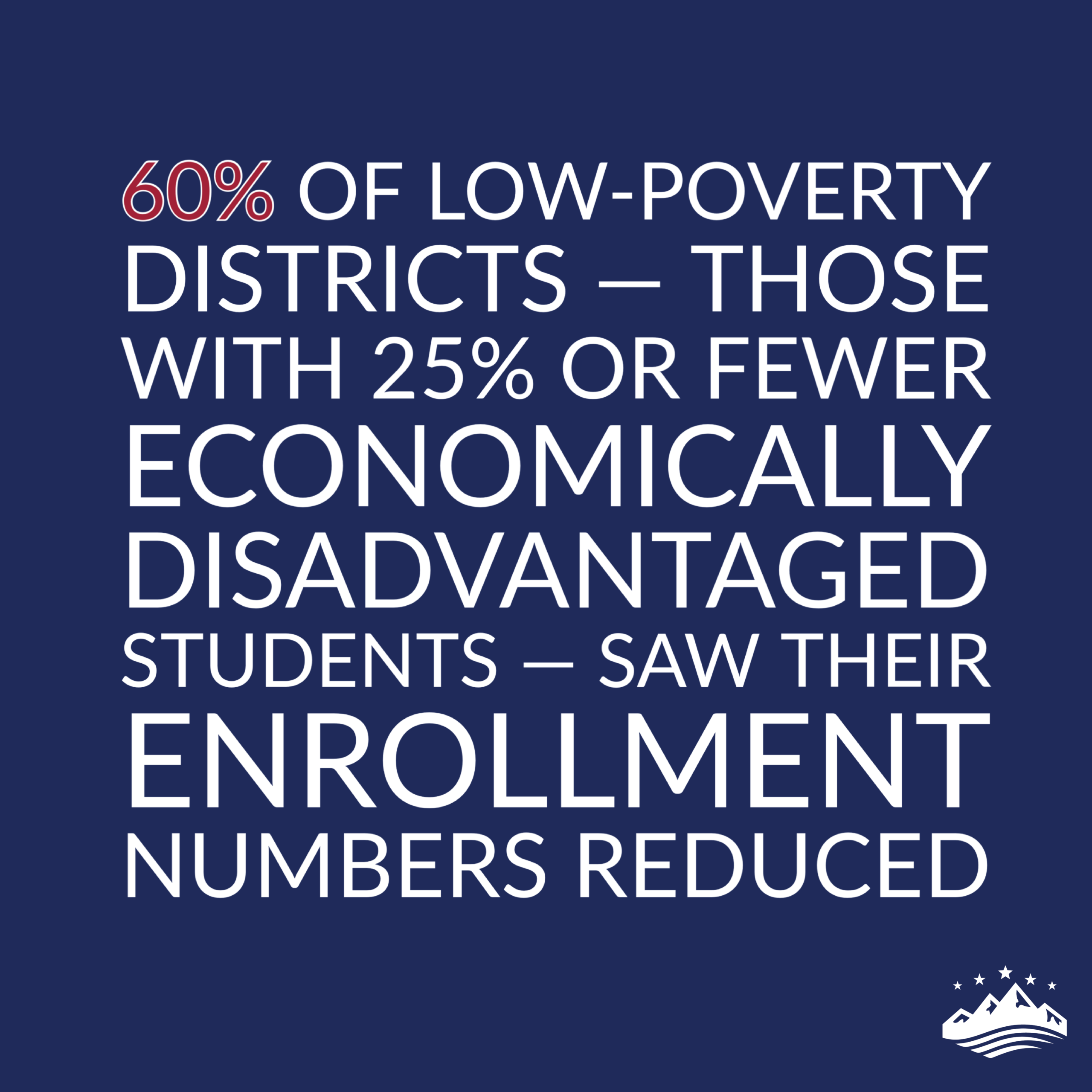
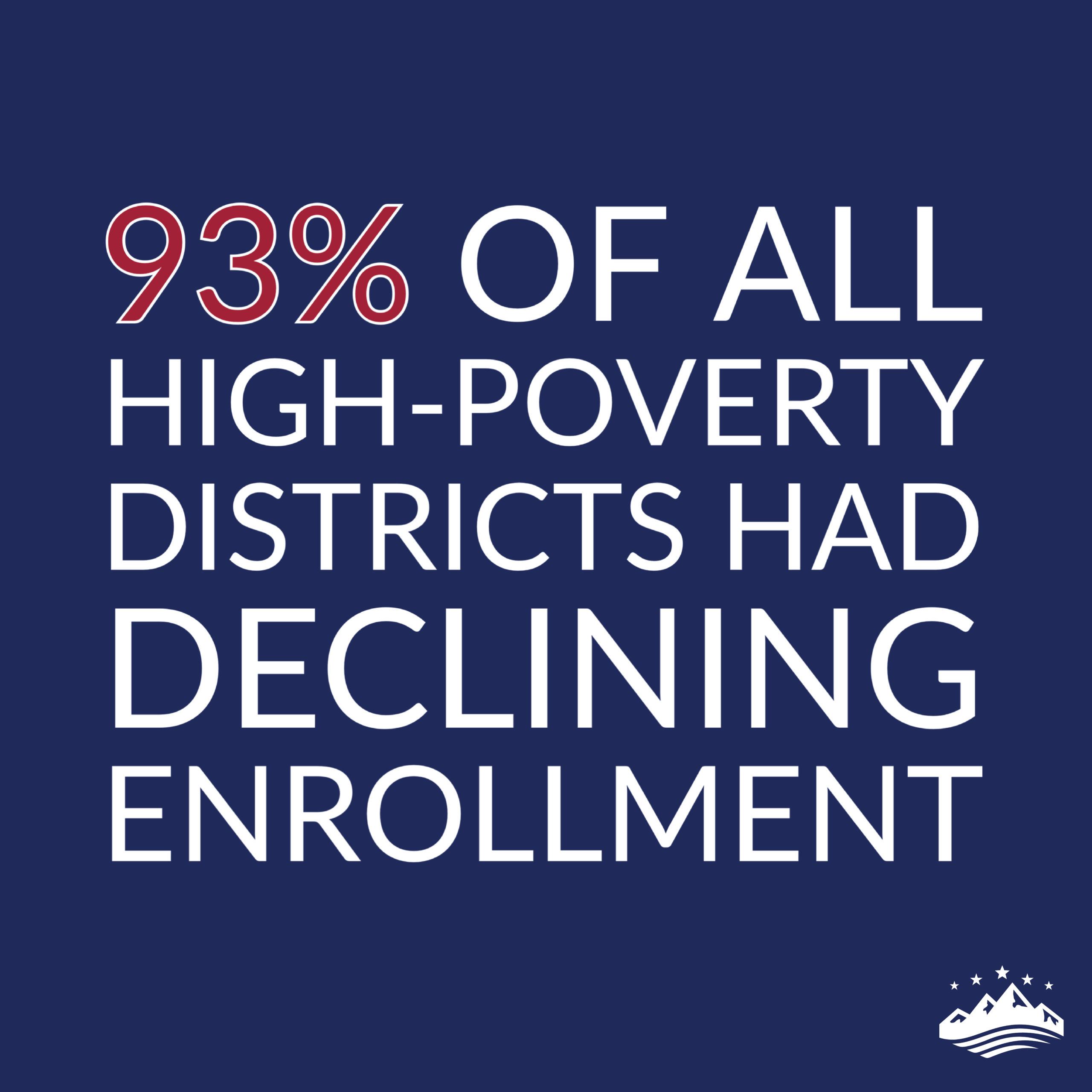
Specific districts in Utah
Other districts have their own unique stories to tell. Salt Lake School District’s prominent enrollment decline has had plenty of news coverage recently as several schools have closed but not without parent pushback. Tooele District’s decrease in enrollment was eye-catching, with more than 50% of its enrollment dropping due in part to cutting ties with My Tech High. Those students wound up going to Nebo, which saw a sizable bump in enrollment, over 17%.
A national look at enrollment
Similar trends are seen across the nation. According to a Brookings Institute report, there has been declining enrollment in public schools since the pandemic, with larger decreases in urban or high-poverty areas. Likewise, according to the report, enrollment in charter and virtual schools has increased across the nation.
Reasons behind enrollment shifts
At the state or local level, the reasons are varied. For example, Utah’s declining enrollment as a state or in certain districts is also being attributed in part to fertility decline.
No doubt, impacts came from the COVID-19 pandemic aftermath – that is, the practical, cultural and political momentum toward education alternatives to the traditional model. As parents were forced to try different models due to things like public school closures, some likely discovered through experience that district school alternatives were better for their children. As schools have reopened since the pandemic, parents’ experiences with alternative models may also be influencing the enrollment of additional students, such as the siblings of pandemic-era students.
An additional factor in enrollment changes, especially future enrollment trends, includes education policy reform. State legislatures, including Utah’s, have passed bills the past couple years to offer new, publicly funded education options outside the traditional district school model. But many of these programs are new or not yet in effect, so it remains to be seen how this impacts enrollment in the long run.
A framework going forward
Some analysts expect the school-age population to continue dwindling until 2060. If enrollment numbers continue to decline, it’s important for policymakers and thought leaders to prepare. Rather than settling for ad hoc responses, policymakers can map out a framework for responding to changes in public schools within a time window where enrollment can be predicted with a certain level of confidence – say in the next three to five years – starting now.
For instance, some analysis suggests higher per-pupil funding for public schools as enrollment declines. How funds are spent is even more important than the amount spent. Looking ahead should include a discussion about how to better spend funds in ways that personalize education.
The framework could include allocating increased per-pupil funding to help the students who need it most. It could also include additional funding to current scholarship programs so they can be implemented, promoted and facilitated to generate the greatest impact on those who need them.
Conclusion
Declining public school enrollment presents challenges for policymakers and administrators, but it also presents opportunities. Utah’s education leaders will have a unique opportunity to chart what Utah’s education landscape will look like for years to come. They can do so intentionally – or reactively. How they choose to approach the early stages of what seems likely to become an uneven trend in changes in public school enrollment could determine which path will be available.

Insights: analysis, research, and informed commentary from Sutherland experts. For elected officials and public policy professionals.

- Enrollment in public district schools has declined in Utah while charter school enrollment has increased.
- While the statewide public district enrollment has decreased overall, enrollment changes vary throughout the state.
- Policymakers have the chance now to plan for the future of public education in Utah with its changing landscape and enrollment trends.
Read More
Education policy to consider during the 2024 election season
Here’s a look at what each presidential candidate is likely to focus on in education, given their track records and campaign platforms.
Ignoring the text of the Constitution is a mistake
A written Constitution is entirely superfluous if the document is simply meant to give the people what they want.
What you need to know about election integrity
It should be easy to vote and hard to cheat. This oft-quoted phrase has been articulated as a guiding principle by many elected officials wading into voting and election policy debates in recent years. So why has this issue been so contentious, and what’s the solution?
